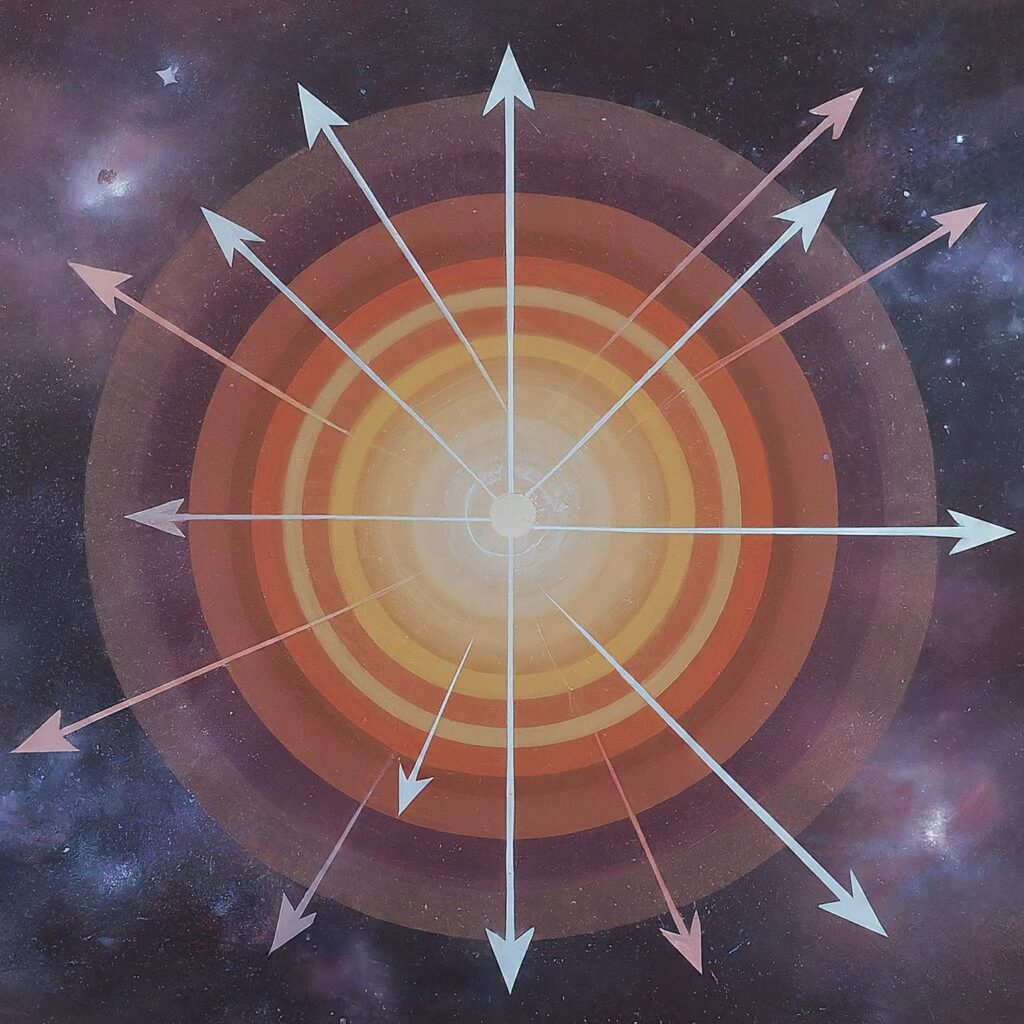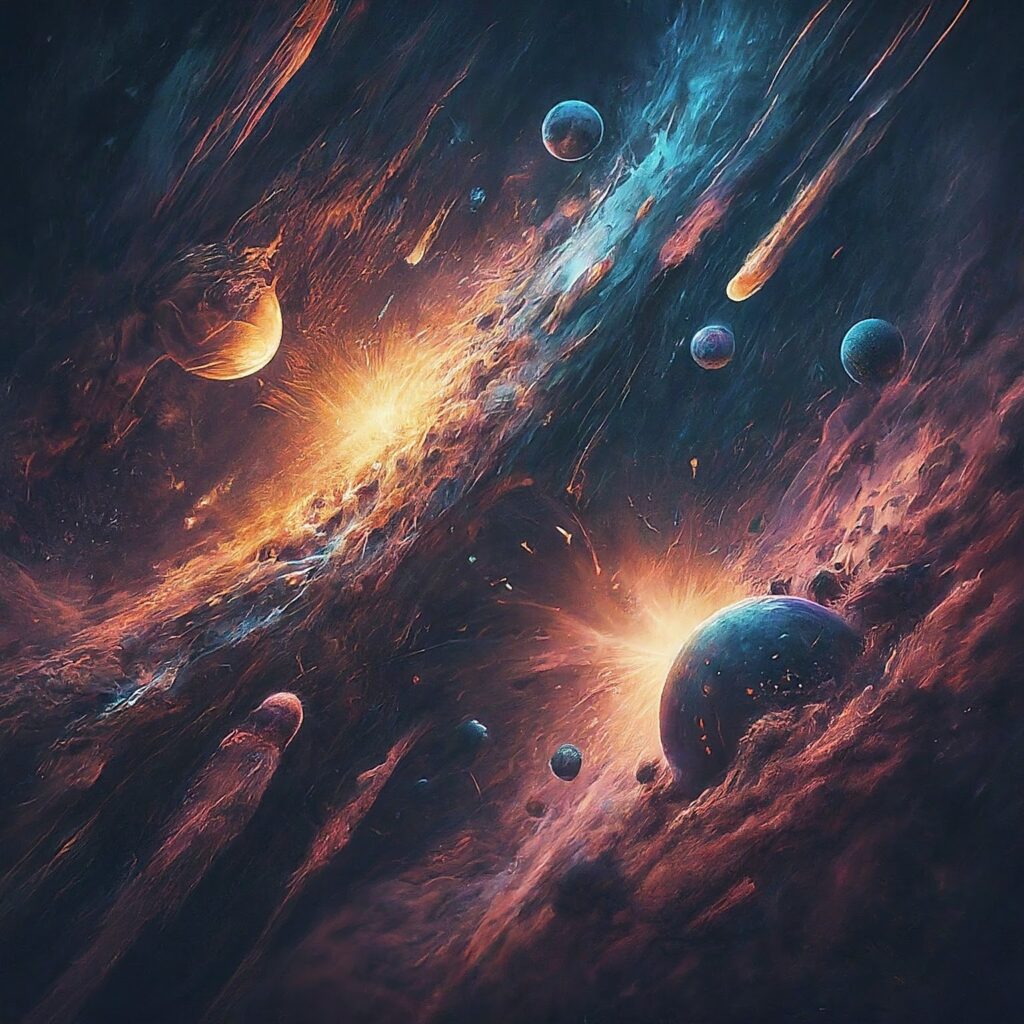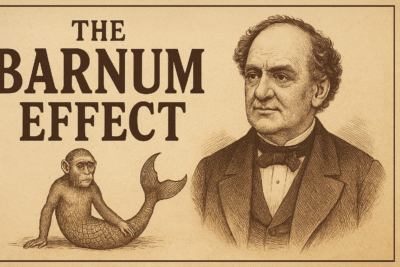
An illustration showing the expansion of the universe
The conventional scientific understanding is that the universe is constantly expanding, and this expansion is accelerating! This means that galaxies are moving further and further apart from each other over time.
Edwin Hubble, an American astronomer, made the groundbreaking discovery of the expanding universe in 1929. He observed that distant galaxies were receding from us at a rate proportional to their distance. This is known as Hubble’s Law.
There are two main theories about what is causing the universe to expand:
- Dark energy: This is a mysterious force that is thought to be pushing galaxies apart. Dark energy makes up about 68% of the universe’s energy content.
- Inflation: This is a period of extremely rapid expansion that is thought to have occurred in the very early universe. Inflation is thought to have smoothed out the universe and set the stage for the formation of galaxies and stars.
The expansion of the universe has a number of implications for our understanding of the cosmos. For example, it means that the universe is finite in age and size (at least as far as the observable universe is concerned). It also means that the conditions in the early universe were very different from the conditions in the universe today.

- Hubble Constant: This value, denoted by H₀, describes how fast the universe is expanding. Imagine galaxies like dots on a balloon; as the balloon inflates, the dots move further apart. The Hubble Constant reflects that rate of separation.
- Measuring H₀: There are two main ways to measure H₀. One method uses the cosmic microwave background (faint afterglow of the Big Bang) to estimate the universe’s properties in its infancy. Another method relies on observing specific types of stars within nearby galaxies and their relation to distance.
- The Tension: The issue is that these two methods provide slightly different values for H₀. Measurements based on the cosmic microwave background suggest a slower expansion rate than those based on nearby galaxies. This discrepancy is called the Hubble tension.
It’s like having two rulers – one says an object is 10 cm long, while the other says it’s 12 cm. They’re both measuring the same thing, but the results don’t agree. This inconsistency is puzzling scientists because both methods are well-established.
Why is Hubble tension important?
It highlights a gap in our current understanding of the universe. Resolving the tension could involve:
- New Theories: Maybe our current understanding of gravity or the universe’s composition needs revision.
- Measurement Refinements: Perhaps there are unknown factors influencing the measurements, requiring more precise techniques.
Ultimately, figuring out the Hubble tension is crucial for creating a more complete picture of the universe’s expansion history and its ultimate fate.

The Hubble tension remains one of cosmology’s most significant unresolved issues. This tension arises from discrepancies between two methods of measuring the universe’s expansion rate. Despite multiple recalibrations and checks, these methods consistently provide conflicting results.
Different Approaches, Diverging Estimates
Scientists use two primary methods to measure the universe’s expansion rate: the cosmic microwave background (CMB) and the cosmic distance ladder. The discrepancy between these two methods is known as the Hubble tension.
Lambda CDM Model Under Scrutiny
In a recent study published in Monthly Notices of The Royal Astronomical Society (MNRAS), scientists from Germany and the UK proposed that the Λ cold dark matter model (Lambda CDM) might be incorrect. This model, which explains various aspects of the universe such as Big Bang radiation and galaxy distribution, may no longer provide an adequate explanation, especially concerning the Hubble tension.
Evidence from Cosmic Microwave Background (CMB)
Cosmologists use the CMB to understand the universe’s structure and expansion. This sea of photons, remnants from the Big Bang, has been analyzed using data from the Wilkinson Microwave Anisotropy Probe (WMAP), BOOMERanG, and Planck satellites. Their findings suggest that the universe is flat with a margin of error of 0.4%.

Insights from the Cosmic Distance Ladder
The cosmic distance ladder, a method for gauging distances to celestial objects, also provides key data about the universe’s expansion rate. One important step in the ladder involves studying Cepheid variable stars, which fluctuate in brightness predictably. By comparing the brightness of these stars, scientists can estimate their distance.
Conflicting Expansion Rates
While the cosmic distance ladder, using Cepheid variable stars and other methods, suggests an expansion rate of approximately 73 km/s per megaparsec, the CMB measurements estimate the rate to be around 68 km/s per megaparsec. This discrepancy is at the heart of the Hubble tension.
The Role of the James Webb Space Telescope
To resolve these discrepancies, researchers have leveraged the advanced capabilities of the James Webb Space Telescope (JWST). Its near-infrared capabilities allow it to penetrate dust clouds and provide more precise measurements of Cepheid variable stars’ distances.
Cross-Verification of Data
A recent study published in The Astrophysical Journal Letters verified data from the Hubble Space Telescope and JWST. Researchers analyzed over a thousand observations of Cepheid variables using JWST, examining potential flaws in Hubble data. Their findings showed “no significant difference” between Hubble and JWST data after correcting for issues like “local crowding” and “choice of filters.”
Is our universe flat?
The geometry of our universe can be classified as open, closed, or flat based on its curvature and future expansion. Each possibility has different implications for the fate and structure of the universe.
Open Universe:
If the universe continues to expand indefinitely without any hindrance, it will be classified as an open universe. In this scenario, the expansion would proceed unchecked, potentially forever.

Closed Universe:
Conversely, if gravitational forces eventually halt the expansion and pull matter back together, the universe could become closed. A closed universe exhibits positive curvature, akin to a sphere. Even though it lacks boundaries, it remains finite. Traveling in such a universe, one could keep moving without encountering an “edge.”
Flat Universe:
There’s a third possibility where the expansion continues forever, but its rate gradually slows down due to gravitational influences. This scenario leads to a flat universe. Despite the term, flatness doesn’t imply two-dimensionality; rather, it refers to the geometric property where parallel lines extend indefinitely without converging or diverging. This flatness would persist even as the universe’s expansion gradually decelerates over an infinitely long timescale.
In summary, cosmologists lean towards a flat universe model currently, where parallel lines in space remain parallel indefinitely. This model aligns with observations and theoretical considerations, suggesting that the universe’s expansion will continue, albeit at a decreasing rate, into the distant future.




What you’ve written here feels timeless — like something that will resonate for years to come.